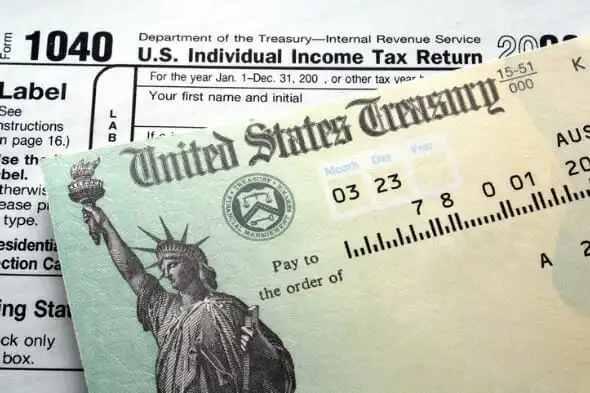For many Americans, filing federal income taxes means getting a refund. The IRS says that the average tax refund in 2024 was approximately $3,000, a minor increase from the previous year. Taxpayers often rely on this money to boost their retirement savings, pay off debt or save for a home. But people who need the money before the IRS issues their refunds sometimes turn to tax refund loans. These loans function like other short-term loans, but the principal amount is based on your refund amount. Refund advances are also a popular alternative.
A financial advisor with tax expertise can potentially build you a financial plan that accounts for your tax situation. Connect with your advisor matches today.
What Is a Tax Refund Loan?
A tax refund loan is officially known as a refund anticipation loan (RAL). It is a loan that a lender makes based on the amount of your federal income tax refund. Lenders are often small financial institutions so this may require a little research on your part to make sure the lender is reputable. Many tax filing services will also offer you a tax refund loan after you file with their service.
Tax refund loans typically only last a couple of weeks – just long enough for the IRS to process your tax refund. The loan that you receive from a lender will have the value of your anticipated refund minus any fees or interest charges. You may receive the loan on a prepaid card, on a check or as an electronic deposit in your bank account. Some lenders only offer one of those methods while others may offer multiple options.
Once the IRS processes your refund, it will go directly to the lender. At this point, your loan is repaid and you made it through tax season. The only other thing to keep in mind is that if your refund is smaller than your tax refund loan, you will still need to pay the loan back in full.
How to Qualify for a Tax Refund Loan
Because tax refund loans do not have as much risk as unsecured loans, credit score requirements are usually not as restrictive. Your qualification depends largely on the amount of money that you will be refunded by the government.
Tax loan lenders will verify your identification, weigh your tax history with the IRS and consider how much debt you owe. You should keep in mind that some lenders may also review your credit history. And if you want to pre-qualify as a candidate, you may need to provide your Social Security number, contact information, and the refund amount that you got for the previous tax year.
How Much Does a Tax Refund Loan Cost?
The biggest reason to avoid tax refund loans is that they are expensive. In some instances, they look eerily similar to payday loans – small, short-term loans with high interest rates. Note that if you get a loan from a well-known tax filing service, you will likely pay less than if you go through a third-party lender.
Lenders may charge an application fee that can be as high as $100. If they are helping you file your taxes, you will need to pay the cost of filing (probably about $40). There will be another fee that depends on how you receive your loan. For example, getting your loan on a prepaid debit card could carry a fee of $30 while getting it on a check might have a $20 fee. Lenders may also charge several other small fees and on top of fees you will need to pay interest for the loan. Your interest rate will be in double digits and in some cases may be triple digits.
All told, you can expect to pay 10% or more of your refund just to get a two-week loan. Of course, you may have to pay more if your refund is delayed or if there are any other issues. Keep in mind that deadlines for tax refund loans are typically early. So child support, back taxes, student loans, and other factors could reduce the amount of money that you expect to get refunded from the IRS.
Where to Get a Tax Refund Loan
A trio of tax-preparation heavyweights – H&R Block, TurboTax and Jackson Hewitt – all offer no-cost tax refund loans to eligible filers. Here’s a look at these three loan programs:
H&R Block’s Refund Advance
If you need your refund now, you may want to consider filing with H&R Block. H&R Block offers something it calls Refund Advance. It’s a short-term loan worth $250, $500, $750, $1,250 or $3,500 depending on your refund amount.
H&R Block charges no interest on the loan. There also aren’t any finance charges or fees. All you need to do is complete a loan application. You will receive the funds for your loan, in most cases, on the same day that the bank approves your application. The loan will be on an H&R Block Emerald Prepaid Mastercard or deposited into a Spruce account.
There are just a couple of caveats. One is that you will need to file your taxes in person at an H&R Block store. Refund Advance is not available for online filers. The second thing to keep in mind is that you will need to pay for the tax-filing service. This is more expensive in person than it is online. You may pay $200 or more just for the filing, depending on the complexity of your return.
TurboTax’s Refund Advance
TurboTax offers Refund Advance loans of up to $4,000, depending on the size of your federal tax refund. The Refund Advance has no loan fees, carries a 0% APR, and does not affect your credit score. The Refund Advance will be deposited into your Credit Karma checking account. You can also use the funds with your Credit Karma Visa debit card wherever Visa is accepted.
Jackson Hewitt’s Tax Refund Advance Loan
Jackson Hewitt offers a Cash Refund Advance Loan, providing taxpayers with early access to their expected refund. This loan is available in amounts ranging from $250 to $3,500, depending on eligibility and anticipated refund size. Jackson Hewitt’s Cash Refund Advance carries no interest or finance charges, making it a cost-effective option for those needing immediate funds. The no-fee advance loan program is available between Jan. 2, 2025 and Feb. 16, 2025.
Jackson Hewitt also offers a tax refund cash advance emergency loan during the holiday season. This expedited cash advance, known as the Early Tax Refund Advance, was available between Dec. 16, 2024 and Jan. 12, 2025.
Reasons to Consider a Tax Refund Loan
The most obvious reason to consider a tax refund loan is because you need money quickly and for the short term. Maybe it’s February and you have a major bill coming up. Or perhaps your emergency fund isn’t quite big enough and you could use the money from your tax refund. While the IRS issues refunds typically within 21 days after getting your return (and can take over six weeks for paper returns), some lenders could get you the money faster, depending on your refund option.
The people who most commonly receive tax refund loans are taxpayers who file early in the tax season and claim the Earned Income Tax Credit (EITC) or the Additional Child Tax Credit (ACTC). Under federal law, the IRS cannot provide tax refunds right away for people who claim these credits. The IRS says that most EITC/ACTC refunds will be available in taxpayer bank accounts or on their debit cards by the end of February.
Risks of Tax Refund Loans

The main concern with a tax refund loan is the cost. Make sure that you understand all of the costs associated with the loan. For example, you may need to pay penalties if your IRS refund doesn’t arrive within a certain amount of time. The last thing you want is for the loan to go delinquent. This will lead to interest and an even higher cost for you.
Another concern is that you receive a lower refund than you anticipated. In that case, you will have borrowed more than you got from the IRS and you will need to come up with the money to pay off the loan. That doesn’t include any extra fees and interest. You can estimate your refund with SmartAsset’s free tax refund calculator.
Sometimes the IRS will also take longer than usual to process your refund. That could be due to an error in your return or because the IRS simply has a lot of returns to process (as is the case early and late in the tax season).
Alternatives to a Tax Refund Loan
Tax refund loans are not usually worth the high cost, so here are a few alternatives that may be better for you:
1. Wait for Your Refund
Yes, waiting is not always the ideal solution but if you e-file your tax return and elect to receive your refund via direct deposit, the IRS may process your return in just one or two weeks. In some cases, waiting two weeks will be better than paying $100 or more for a short loan. Keep in mind that different filing methods will take longer.
2. Lower Your Tax Refund
If you’re getting a big tax refund every year, it means you’re overpaying on your taxes throughout the year. It’s nice to get a big refund check, but you could also have that money in your bank account during the year, which may help avoid a situation where you’re short on cash and relying on a refund loan. To do that, you would need to fill out your W-4 more accurately. This will require a bit more planning on your part but it’s a good way to maximize your take-home pay.
3. Find a Free Refund Advance
Tax filing services are one of the biggest lenders for tax refund loans. These services usually call them refund advances and offer them mostly as a way to entice new customers. The result has been that some refund advance loans are very cheap or even free. Below are two free refund advance loans you should consider.
Bottom Line

A tax refund loan is a short-term loan that you can use to get the value of your federal income tax refund just a bit sooner. They are popular for people who claim the EITC and need a little help making ends meet early in the year.
However, tax refund loans are not the best option for most people because they are very expensive. After deducting all fees and interest, you may have to pay 10% or more of your refund just to get a loan for a couple of weeks. If you really need some financial help, consider getting a refund advance instead. Tax filing services like H&R Block and TurboTax offer big advances at little or no cost to you.
Tips for Getting Through Tax Season
- If you find yourself relying on a big refund check to pay the bills, your financial plan might need tweaking. Consider working with a financial advisor to develop a tax strategy for your financial goals. Finding a qualified financial advisor doesn’t have to be hard. SmartAsset’s free tool matches you with vetted financial advisors who serve your area, and you can have a free introductory call with your advisor matches to decide which one you feel is right for you. If you’re ready to find an advisor who can help you achieve your financial goals, get started now.
- If you’re getting a big tax refund every year, it’s because you overpaid on your paycheck taxes during the year. This is the case for most taxpayers. It’s nice to get a big check in the mail but it’s also nice to have that money throughout the year. We recommend adjusting your withholding by filling out a new W-4 and then putting the extra money in a high-interest bank account. You could increase your annual earnings and better cover your expenses throughout the year.
- If you’re looking to e-file your tax return without the help of a professional tax preparer, you’ll need to choose a tax-filing program to use. In addition to TurboTax and H&R Block, we have reviews on a number of services, including Jackson Hewitt, FreeTaxUSA and Credit Karma.
Photo credit: ©iStock.com/cabania, ©iStock.com/scyther5, ©iStock.com/AntonioGuillem
